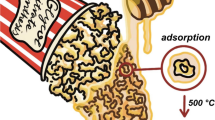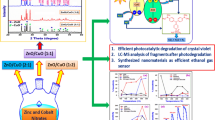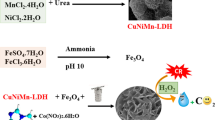Abstract
The decomposition of CuH nanoparticles in aqueous solution has been successfully developed as a novel method for the preparation of Cu2O nanoparticles. In particular, we found that the decomposition of CuH nanoparticles in aqueous solution could be catalyzed by Au colloids, forming Cu2O-Au nanocomposites. The composition and structure of the resulting Cu2O-Au nanocomposites have been characterized in detail by inductively coupled plasma atomic emission spectroscopy, powder X-ray diffraction, N2 adsorption-desorption isotherms, infrared spectroscopy, X-ray photoelectron spectroscopy, scanning electron microscopy and transmission electron microscopy. Their visible-light-driven photocatalytic activity toward various dye molecules has also been investigated. Depending on the Au:Cu ratio, Cu2O-Au nanocomposites exhibit different novel nanostructures including a beautiful flower-like nanostructure that consists of polycrystalline Cu2O, amorphous Cu2O and Au colloids. We propose that the rapidly-generated bubbles of H2 during the course of the catalytic decomposition reaction drive the simultaneously-formed Cu2O to form amorphous curved thin foils and might also act as a template to assemble curved thin foils of amorphous Cu2O, polycrystalline Cu2O and Au colloids into uniform nanostructures. A Cu2O-Au nanocomposite with a Cu:Au ratio of 40 exhibits remarkable chemisorption capacity and visible-light-driven photocatalytic activity towards methyl orange and acid orange 7 and is a promising chemisorption-photocatalysis integrated catalyst. The catalytic decomposition of the metal hydride might open up a new approach for the fabrication of other metal/metal oxide nanocomposites with novel nanostructures and properties.

Similar content being viewed by others
References
Shen, M. Y.; Yokouchi, T.; Koyama, S.; Goto, T. Dynamics associated with Bose-Einstein statistics of orthoexcitons generated by resonant excitations in cuprous oxide. Phys. Rev. B 1997, 56, 13066–13072.
Rai, B. P. Cuprous oxide solar cells: A review. Solar Cells 1988, 25, 265–272.
Zhang, J.; Liu, J.; Peng, Q.; Wang, X.; Li, Y. Nearly monodisperse Cu2O and CuO nanospheres: Preparation and applications for sensitive gas sensors. Chem. Mater. 2006, 18, 867–871.
Poizot, P.; Laruelle, S.; Grugeon, S.; Dupont, L.; Taracon, J. M. Nano-sized transition-metal oxides as negative-electrode materials forlithium-ion batteries. Nature 2000, 407, 496–499.
Bao, H. Z.; Zhang, W. H.; Shang, D. L.; Hua, Q.; Ma, Y. S.; Jiang, Z. Q.; Yang, J. L.; Huang, W. X. Shape-dependent reducibility of cuprous oxide nanocrystals. J. Phys. Chem. C 2010, 114, 6676–6680.
Hara, M.; Kondo, T.; Komoda, M.; Ikeda, S.; Shinohara, K.; Tanaka, A.; Kondo, J. N.; Domen, K. Cu2O as a photocatalyst for overall water splitting under visible light irradiation. Chem. Commun. 1998, 357–358.
de Jongh, P. E.; Vanmaekelbergh, D.; Kelly, J. J. Cu2O: A catalyst for the photochemical decomposition of water? Chem. Commun. 1999, 1069–1070.
Hara, M.; Komoda, M.; Hasei, H.; Yashima, M.; Ikeda, S.; Takata, T.; Kondo, J. N.; Domen, K. A study of mechano-catalysts for overall water splitting. J. Phys. Chem. B 2000, 104, 780–785.
Walker, A. V.; Yates, J. T. Jr. Does cuprous oxide photosplit water? J. Phys. Chem. B 2000, 104, 9038–9043.
Kuo, C. -H.; Huang, M. H. Facile synthesis of Cu2O nanocrystals with systematic shape evolution from cubic to octahedral structures. J. Phys. Chem. C 2008, 112, 18355–18360.
Zhang, D. -F.; Zhang, H.; Guo, L.; Zheng, K.; Han, X. -D.; Zhang, Z. Delicate control of crystallographic facet-oriented Cu2O nanocrystals and the correlated adsorption ability. J. Mater. Chem. 2009, 19, 5220–5225.
Ho, J. Y.; Huang, M. H. Synthesis of submicrometer-sized Cu2O crystals with morphological evolution from cubic to hexapod structures and their comparative photocatalytic activity. J. Phys. Chem. C 2009, 113, 14159–14164.
Zheng, Z.; Huang, B.; Wang, Z.; Guo, M.; Qin, X.; Zhang, X.; Wang, P.; Dai, Y. Crystal faces of Cu2O and their stabilities in photocatalytic reactions. J. Phys. Chem. C 2009, 113, 14448–14453.
Zhang, Y.; Deng, B.; Zhang, T. R.; Dao, D. M.; Xu, A. W. Shape effects of Cu2O polyhedral microcrystals on photocatalytic activity. J. Phys. Chem. C 2010, 114, 5073–5079.
Xu, H.; Wang, W.; Zhu, W. Shape evolution and size-controllable synthesis of Cu2O octahedra and their morphology-dependent photocatalytic properties. J. Phys. Chem. B 2006, 110, 13829–13834.
Shi, J.; Huang, X.; Tan, Y. Synthesis and enhanced photocatalytic activity of regularly shaped Cu2O nanowire polyhedra. Nano Res. 2011, 4, 448–459.
Ng, C. H. B.; Fan, W. Y. Shape evolution of Cu2O nanostructures via kinetic and thermodynamic controlled growth. J. Phys. Chem. B 2006, 110, 20801–20807.
Kuo, C. -H.; Chen, C. -H.; Huang, M. H. Seed-mediated synthesis of monodispersed Cu2O nanocubes with five different size ranges from 40 to 420 nm. Adv. Funct. Mater. 2007, 17, 3773–3780.
Gou, L.; Murphy, C. J. Solution-phase synthesis of Cu2O nanocubes. Nano. Lett. 2003, 3, 231–234.
Siegfried, M. J.; Choi, K. -S. Directing the architecture of cuprous oxide crystals during electrochemical growth. Angew. Chem. Int. Ed. 2005, 44, 3218–3223.
Siegfried, M. J.; Choi, K. -S. Electrochemical crystallization of cuprous oxide with systematic shape evolution. Adv. Mater. 2004, 16, 1743–1746.
Li, H.; Liu, R.; Zhao, R.; Zheng, Y.; Chen, W.; Xu, Z. Morphology control of electrodeposited Cu2O crystals in aqueous solutions using room temperature hydrophilic ionic liquids. Cryst. Growth Des. 2006, 6, 2795–2798.
Lu, C.; Qi, L.; Yang, J.; Wang, X.; Zhang, D.; Xie, J.; Ma, J. One-pot synthesis of octahedral Cu2O nanocages via a catalytic solution route. Adv. Mater. 2005, 17, 2562–2567.
Teo, J. J.; Chang, Y.; Zeng, H. C. Fabrications of hollow nanocubes of Cu2O and Cu via reductive self-assembly of CuO nanocrystals. Langmuir 2006, 22, 7369–7377.
Chang, Y.; Teo, J. J.; Zeng, H. C. Formation of colloidal CuO nanocrystallites and their spherical aggregation and reductive transformation to hollow Cu2O nanospheres. Langmuir 2005, 21, 1074–1079.
Xu, H.; Wang, W. Template synthesis of multishelled Cu2O hollow spheres with a single-crystalline shell wall. Angew. Chem. Int. Ed. 2007, 46, 1489–1492.
Pan, M. L.; Zeng, H. C. Highly ordered self-assemblies of submicrometer Cu2O spheres and their hollow chalcogenide derivatives. Langmuir 2010, 26, 5963–5970.
Kuo, C. -H.; Huang, M. H. Fabrication of truncated rhombic dodecahedral Cu2O nanocages and nanoframes by particle aggregation and acidic etching. J. Am. Chem. Soc. 2008, 130, 12815–12820.
Sui, Y.; Fu, W.; Zeng, Y.; Yang, H.; Zhang, Y.; Chen, H.; Li, Y.; Li, M.; Zou, G. Synthesis of Cu2O nanoframes and nanocages by selective oxidative etching at room temperature. Angew. Chem. Int. Ed. 2010, 49, 4282–4285.
Singh, D. P.; Neti, N. R.; Sinha, A. S. K.; Srivastava, O. N. Growth of different nanostructures of Cu2O (nanothreads, nanowires, and nanocubes) by simple electrolysis based oxidation of copper. J. Phys. Chem. C 2007, 111, 1638–1645.
Wang, W.; Wang, G.; Wang, X.; Zhan, Y.; Liu, Y.; Zheng, C. Synthesis and characterization of Cu2O nanowires by a novel reduction route. Adv. Mater. 2002, 14, 67–69.
Tan, Y.; Xue, X.; Peng, Q.; Zhao, H.; Wang, T.; Li, Y. Controllable fabrication and electrical performance of single crystalline Cu2O nanowires with high aspect ratios. Nano. Lett. 2007, 7, 3723–3728.
Hong, X.; Wang, G.; Zhu, W.; Shen, X.; Wang, Y. Synthesis of sub-10 nm Cu2O nanowires by poly(vinyl pyrrolidone)-assisted electrodeposition. J. Phys. Chem. C 2009, 113, 14172–14175.
Yuhas, B. D.; Yang, P. Nanowire-based all-oxide solar cells. J. Am. Chem. Soc. 2009, 131, 3756–3761.
Kuo, C. -H.; Huang, M. H. Morphologically controlled synthesis of Cu2O nanocrystals and their properties. Nano Today 2010, 5, 106–116.
Kuo, C. H.; Hua, T. E.; Huang, M. H. Au nanocrystal-directed growth of Au-Cu2O core-shell heterostructures with precise morphological control. J. Am. Chem. Soc. 2009, 131, 17871–17878.
Kuo, C. H.; Yang, Y. C.; Gwo, S.; Huang, M. H. Facet-dependent and Au nanocrystal-enhanced electrical and photocatalytic properties of Au-Cu2O core-shell heterostructures. J. Am. Chem. Soc. 2011, 133, 1052–1057.
Hu, H.; Yu, J.; Liu, S.; Mann, S. Template-free hydrothermal synthesis of CuO/Cu2O composite hollow microspheres. Chem. Mater. 2007, 19, 4327–4334.
Zhang, Y. G.; Ma, L. L.; Li, J. L.; Yu, Y. In situ Fenton reagent generated from TiO2/Cu2O composite film: A new way to utilize TiO2 under visible light irradiation. Environ. Sci. Technol. 2007, 41, 6264–6269.
Li, J. L.; Liu, L.; Yu, Y.; Tang, Y. W.; Li, H. L.; Du, F. P. Preparation of highly photocatalytic active nano-size TiO2-Cu2O particle composites with a novel electrochemical method. Electrochem. Commun. 2004, 6, 940–943.
Lalitha, K.; Sadanandam, G. Kumari, V. D.; Subrahmanyam, M.; Sreedhar, B.; Hebalkar, N. Y. Highly stabilized and finely dispersed Cu2O/TiO2: A promising visible sensitive photocatalyst for continuous production of hydrogen from glycerol:water mixtures. J. Phys. Chem. C 2010, 114, 22181–22189.
Goedkoop, J. A.; Andresen, A. F. The crystal structure of copper hydride. Acta Crystallogr. 1955, 8, 118–119.
Moulder, T. F.; Stickle, W. F.; Sobol, P. E.; Bomben, K. D. Handbook of X-ray Photoelectron Spectroscopy; Perkin Elmer: Eden Prairie, Minnesota, 1992.
Kelly, K. L.; Coronado, E.; Zhao, L. L.; Schatz, G. C. The optical properties of metal nanoparticles: The influence of size, shape, and dielectric environment. J. Phys. Chem. B 2003, 107, 668–677.
Tong, G.; Guan, J.; Xiao, Z.; Mou, F.; Wang, W.; Yan, G. In situ generated H2 bubble-engaged assembly: A one-step approach for shape-controlled growth of Fe nanostructures. Chem. Mater. 2008, 20, 3535–3539.
Hua, Q.; Huang, W. X. Chemical etching induced shape change of magnetite microcrystals. J. Mater. Chem. 2008, 18, 4286–4290.
Nagase, K.; Zheng, Y.; Kodama, Y. Kakuta, J. Dynamic study of the oxidation state of copper in the course of carbon monoxide oxidation over powdered CuO and Cu2O. J. Catal. 1999, 187, 123–130.
Bauer, C.; Jacques, P.; Kalt, A. Investigation of the interaction between a sulfonated azo dye (AO7) and a TiO2 surface. Chem. Phys. Lett. 1999, 307, 397–406.
Saito, Y.; Kim, B.; Machida, K.; Uno, T. The coordinative behavior of the ethereal oxygen atom in cobalt, nickel and copper complexes with Schiff bases obtained from salicylaldehyde derivatives and 2-(aminomethyl)furan. Bull. Chem. Soc. Jpn. 1974, 47, 2111–2114.
Chen, C.; Ma, W.; Zhao, J. Semiconductor-mediated photo-degradation of pollutants under visible-light irradiation. Chem. Soc. Rev. 2010, 39, 4206–4219.
Hoffmann, M. R.; Martin, S. T.; Choi, W.; Bahnemann, D. W. Environmental applications of semiconductor photocatalysis. Chem. Rev. 1995, 95, 69–96.
Author information
Authors and Affiliations
Corresponding author
Electronic supplementary material
Rights and permissions
About this article
Cite this article
Hua, Q., Shi, F., Chen, K. et al. Cu2O-Au nanocomposites with novel structures and remarkable chemisorption capacity and photocatalytic activity. Nano Res. 4, 948–962 (2011). https://doi.org/10.1007/s12274-011-0151-8
Received:
Revised:
Accepted:
Published:
Issue Date:
DOI: https://doi.org/10.1007/s12274-011-0151-8




